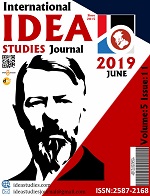Author :
Abstract
Ülke ekonomilerinin gelişim kadar önemli olan bir diğer konu da çevre sorunlarıdır. Ekonomik gelişim ve çevre arasındaki ilişki, sürdürülebilirlik açısından ele alınan önemli bir konudur. Bu bağlamda bu çalışmada ekonomik gelişme ve çevre sorunları sürecinde oluşan kirlilik sığınağı hipotezi değerlendirilmektedir. Bu ilişkiyi analiz etmek için Çin’in 1995-2015 dönemi arası için bir nedensellik analizi yapılmıştır. Analiz sonucu ise Çin’de doğrudan yabancı yatırımların CO2 emisyonuna neden olduğu gözlenmiştir.
Keywords
Abstract
Another issue that is as important as the development of national economies is the environmental problems. The relationship between economic development and the environment is an important issue in terms of sustainability. In this context, in this study, the pollution refuge hypothesis which is formed in the process of economic development and environmental problems is evaluated. To analyze this relationship, a causality analysis was conducted for China's 1995-2015 period. As a result of the analysis, it was observed that foreign direct investments in China caused CO2 emissions.
Keywords
- Acharya, (2009), “Fdı, Growth And The Envıronment: Evıdence From Indıa On Co2 Emıssıon
- Acharya, (2009), “Fdı, Growth And The Envıronment: Evıdence From Indıa On Co2 EmıssıonDurıng The Last Two Decades”, Journal Of Economıc Development: 43, Volume: 34, Number 1, June, ss. 43-58.
- Ahmad, N. Lu, L. Ju, J. Wang, J. Li. H. Hashmi. M. Z. (2017), “Modelling The CO2 EmissionsAnd Economic Growth İn Croatia: Is There Any Environmental Kuznets Curve?, Science Direct, Energy 123 (2017), pp. 164-172.
- Ahmed, K. (2014), “Environmental Kuznets curve for CO2 emission in Mongolia: An empirical analysis”, An International Journal, Vol. 25 Iss 4 pp. 505 – 516.
- Arrow, K., Bolin, B., Costanza, R., Folke, C., Holling, C.S., Janson, B., Levin, S., Maler, K.,Perrings, C., Pimental, D., (1995). “Economic Growth, Carrying Capacity, And The Environment”. Ecological Economi, Cilt 15, Sayı 2 , Kasım, ss. 91-95.
- Boden, T.A., Marland, G., and Andres, R.J. (2017).” National CO2 Emissions from Fossil-FuelBurning, Cement Manufacture, and Gas Flaring”, 1751-2014, Carbon Dioxide Information AnalysisCenter, Oak Ridge National Laboratory, U.S. Department of Energy, doi 10.3334/CDIAC/00001_V2017.
- Cave, L. A. Blomquist, G. C. (2008), “Environmental policy in the European Union: Fostering the development of pollution havens?, e c o l o g ı c a l e c o n o m ı c s 6 5, pp. 2 5 3 – 2 6 1.
- Carson, R. T. Jeon, Y. & Mccubbin, D. R. (1997), “The Relationship Between Air PollutionEmissions And İncome: US Data”, Environmental ve Devolopment Economics, Vol: 2, Issue: 4, pp. 433-450.
- Chacrobaty, D. Mukherjee, B. (2010), “Relationship between Trade, Investment and Environment:A Review of Issues”, Munich Personal RePEc Archive, No. 23333, posted 16. June, http://mpra.ub.uni-muenchen.de/23333/.
- Cole, M. A. Elliot, R. J. & Fredrikson, P. (2006),” Endogenous Pollution Havens: Does FDI
- Influence Environmental Regulations?, Scand. J. of Economics 108(1), pp. 157–178, 2006 DOI: 10.1111/j.1467-9442.2006.00439.x.
- Copeland, B.R. (2008). “The pollution haven hypothesis. from Kevin P. Gallagher (ed.) Handbook on Trade and the Environment”, Edward Elgar Publishing, Cheltenham, UK, ss. 116-125.
- Destek, M. A. & Özsoy, F. N. (2015), “Relationships Between Economic Growth, EnergyConsumption, Globalization, Urbanization And Environmental Degradation İn Turkey”, International Journal of Energy and StatisticsVol. 03, No. 04, 1550017.7
- Dickey, D.A., Fuller, W.A. (1979). “Distributions of the estimators for autoregressive time series with a unit root”, Journal of the American Statistical Association 74, ss.427-431.
- Dinda, S. (2004), “Environmental Kuznets Curve Hypothesis: A Survey”, Ecological Economics, No: 49, ss. 431-455.
- Georgescu-Roegen, N. (1973). The Entropy Law and the Economic Problem. Dans Daly, H.E. (ed), Towards a Steady-State Economy. New York: W. H. Freeman.
- Granger, C. W. J. (1969). Investigating Causal Relations by Econometric Models and Cross- Spectral Methods, Econometrica, 37, 424-438.
- He, J. (2007), “ Is the Environmental Kuznets Curve hypothesis valid for developing countries? A survey”,Cahiers de recherche 07-03, Sherbrooke de l'école de gestion à l'Université de France.
- Hettige, H. Man, M & Wheleer, D. (2000), “Industrial pollution in economic development: theenvironmental Kuznets curve revisited” Journal of Development Economics Vol. 62, pp. 445–476.
- Katrakilidis, C. Kyritsis, I. Patriska, V. (2015), “The dynamic linkages between economic growth,environmental quality and health in Greece”, Applied Economics Letters, October, http://dx.doi.org/10.1080/13504851.2015.1066482.
- Kuznets, S.(1955). “Economic Growth And İncome İnequality”. American Economic Review,45, pp. 1–28.
- Mani, M. & Wheeler, D. (1997), “In Search of Pollution Havens? Dirty Industry in the WorldEconomy, 1960 to 1995”, The Journal of Environment & Devolopment, vol: 7, No: 3, pp. 215- 247.
- Meadows, D.H., D.L. Meadow, J. Randers, and W. Behrens (1972). “The Limit to Growth”, Universe Books, New York.
- Neumayer, P. (2000), “Trade and the Environment: A Critical Assesment and Some Suggestions for Reconcliation”, Journal of Environment & Development, Vol. 9(2), Switzerland, ss.138-139.
- Plow, P. & Yeats, A. (1992), “Do Dirty Industries Migrate?”, P.Plow (Der.), Intertional Trade and Environmental içinde, World Bank Discussion Paper, 159, ss. 89-104.
- Sinha, A.& Bihat, M. Y. (2017),” Environmental Kuznets Curve for CO2and NOx emissions: A
- Case Study of India”, European Journal of Sustainable Development, 6, 1, pp. 267-276 2239- Doi: 10.14207/ejsd.2017.v6n1p267.
- Strand, J. (2002), “Environmental Kuznets Curves: Empirical Relationships BetweenEnvironmental Quality And Economic Development”, Department of Economics University ofOslo, MEMORANDUM, No 04, https://www.duo.uio.no/bitstream/handle/10852/17288/4727.pdf?sequence=1.
- Şahinöz, A. & Fotourehchi, Z. (2014), “Kirlilik Emisyonu ve Doğrudan Yabancı SermayeYatırımları: Türkiye için “Kirlilik Sığınağı Hipotezi” “, Sosyo Ekonomi, 1, January- June, ss. 187- 210.
- Taguchi, H. (2012), “The Envıronmental Kuznets Curve In Asıa: The Case Of Sulphur And Carbon Emıssıons”, A Vol. 19, No. 2, December, pp. 77-92.
- Uchiyama, K. (2016), “Environmental Kuznets Curve Hypothesis Carbon Dioxide Emissions”, VII,63 p, 1, Development Bank of Japan Research Series, www. Springer. Com/978-4-431-55919-1.Ulucak, R. & Ekrem, E. (2012). “Çevre-İktisat İlişkisi Ve Türkiye’de Çevre Politikalarının Etkinliği”. Akademik Araştırmalar Ve Çalışmalar Dergisi. Cilt:4. Sayı:6. ss:78-98.
- http://www.globalcarbonatlas.org/en/CO2-emissions. E.T. 16.12.2018.
- http://www.moment-expo.com/dunyanin-yatirim-ussu-cin. E.T. 17.12.2018. www.worlddevolopmentındicator.
- http://turkish.cri.cn/1781/2017/10/13/1s185971.htm.E.T. 17.12.2018.
